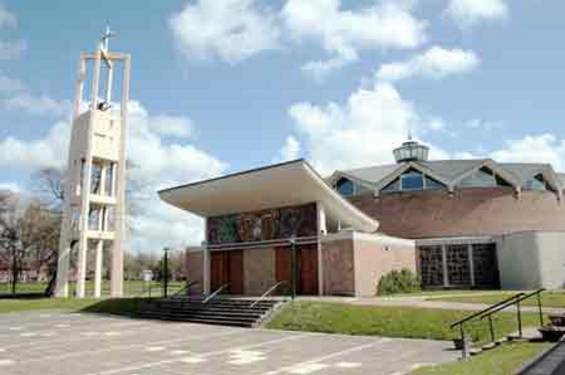This website uses cookies
This website uses cookies to enable it to function properly and to analyse how the website is used. Please click 'Close' to accept and continue using the website.



May 2008 - St Mary’s, Leyland, near Preston, 1961-4
Text and Images by Robert Proctor
Despite its sudden expansion in the 1950s with the arrival of the car industry, Leyland remains a pleasant Lancashire town of Victorian terraced cottages and suburban greenery. It would seem an unlikely setting for the modern Roman Catholic church of St Mary’s, but the church resulted from the enlightened patronage of Leyland’s Benedictine priory, in particular its parish priest, Edmund Fitzsimons, who had undertaken a tour of Europe to view the latest in experimental church design.
The architect was Polish immigrant Jerzy Faczynski of Weightman & Bullen, a Liverpool firm specialising in schools and churches for the Roman Catholic Archdiocese. Faczynski’s design of 1961 was circular, influenced by Frederick Gibberd’s winning design for Liverpool Metropolitan Cathedral – similar in its external ring of side chapels, separate Blessed Sacrament Chapel on axis at the east end, and in locating the altar in the centre; similar also to the original design in raking the pews like a theatre in the round. Patrick Reyntiens even popped up from Liverpool to do the chunky green and purple dalle-de-verre windows.
St Mary’s differed from the Cathedral in its more expressive radial folded-slab roof and oculus, and in providing a ring of V-shaped columns inside the central space. This allowed a processional circuit around the edge of the interior, something which seems not to have occurred to Gibberd, but here allowed the church’s use for a secondary ritual, the Stations of the Cross. The images at the stopping points of this circuit were created by sculptor Arthur Dooley as spindly dark bronze figures, placed between the branches of the columns and facing outwards, to be viewed from the aisle silhouetted against the church’s interior. They are perhaps the most significant artworks in a church which is crammed with 1960s design.
Every object in the church seems to have been made especially for it: the candlesticks are spiky and lumpy arts and crafts objects; there is a crucifix by Adam Kossowski, a tapestry reredos in the Blessed Sacrament Chapel designed by the architect (made by the Edinburgh Tapestry Company), and a tabernacle by Robin McGhie; even a holy water dispenser with taps and biblical message.
The Blessed Sacrament Chapel is itself a miniature study in church design, with its roof pulled upwards and wall pulled outwards to flood the sanctuary with sunlight. Adam Kossowski, whose ceramic work turns up at other Weightman & Bullen churches, was also responsible for the colourful frieze over the entrance depicting a Last Judgement of almost Romanesque grimness, the angels’ eyes popping out with the fearsomeness of their trumpet blowing, and the faces of the damned falling into a terrified abstraction and already tinged with red from the approaching hellfire. It gives a note of archaism to the exterior, which is otherwise dominated by the finely finished tapered concrete campanile, clean salmon coloured brickwork, and the Ronchamp curves of its sweeping entrance canopy.
Perhaps the insistence on the specialness of everything in this church is slightly overwhelming; but since its opening in 1964 it has been well looked after by a community that clearly takes pride in it, and is a thought-provoking treasure-trove of post-war religious architecture, art and design.
Robert Proctor is Lecturer in History of Architecture at the Mackintosh School of Architecture, Glasgow School of Art. He is currently researching post-war Roman Catholic church architecture in Britain.
Look for past Buildings of the Month by entering the name of an individual building or architect or browsing the drop down list.

Become a C20 member today and help save our modern design heritage.